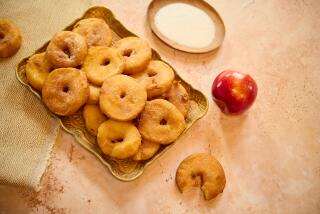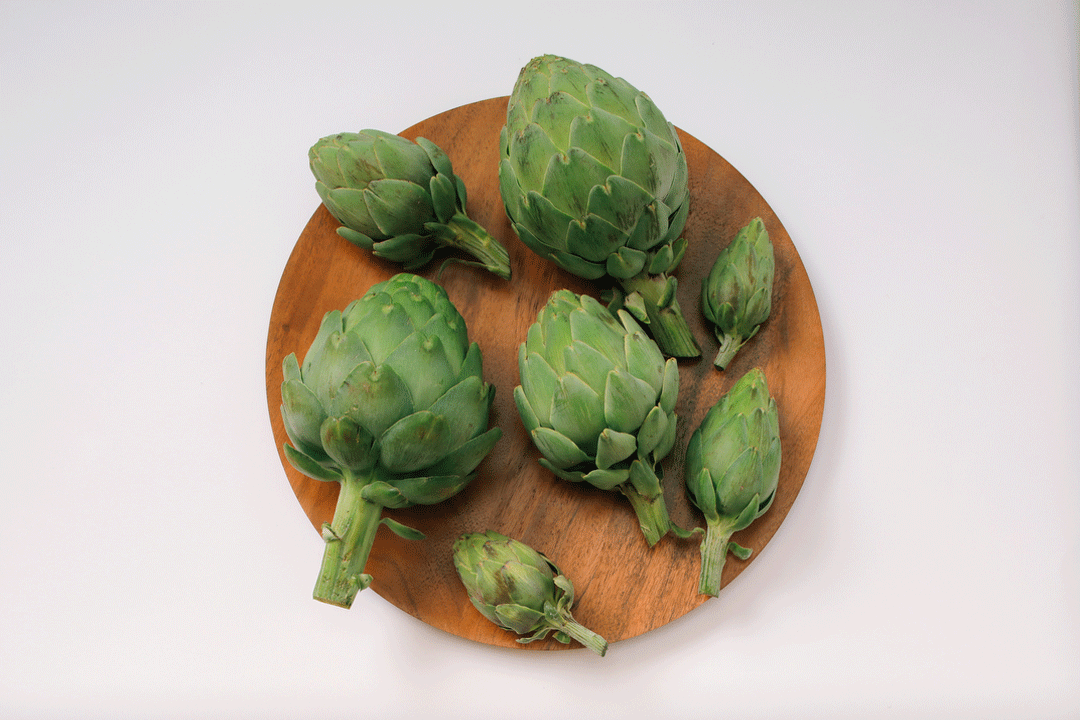Jerusalem Artichoke: Tuber by Any Other Name : Gnarled Vegetable, Similar to a Potato, Is Actually the Root of a Sunflower
- Share via
This is a story about a vegetable with an image problem, a farmer with a dream and a publicist with a mission.
The vegetable is the Jerusalem artichoke--a gnarled tuber that is neither from Jerusalem nor an artichoke, but is actually the root of a sunflower.
The farmer is Doug Ness, a Minnesotan recently transplanted to Idaho, the tuber capital of the country. With his company of five, Ness is hoping to make the Jerusalem artichoke as common as the carrot.
The publicist is Willetta Warberg, an Idaho marketing consultant who is determined to rid the Jerusalem artichoke of its misnomer.
Warberg and Ness have given an old vegetable another name: Sun Roots. They have applied to register Sun Roots as a trademark and are plugging their product as the latest “new” food.
The Ness-Warberg campaign has resulted in Sun Roots’ being sold in the specialty-produce sections of some supermarkets.
Hopes to Widen Market
Ness certainly isn’t the only one trying to develop a food market for the vegetable, which is similar in use to the potato. There have long been small-farm growers in other states.
Frieda Caplan, a gourmet-food wholesaler in Los Angeles, has been selling the tubers to supermarkets around the country under the name Sunchokes for 17 years. (Caplan said that although the name Sunchoke is a registered trademark, she has not tried to stop other companies from using it, in the hopes of widening the market.)
While the demand is still small, a glut in the supply of Jerusalem artichokes has made for a lot of confusion in the marketing, according to Caplan.
Ness estimates that there are about 40,000 acres of Jerusalem artichokes rooting in the Midwest, waiting for a market. To Ness, that market is fresh food.
Although the tuber has thus far been sold primarily in the specialty-food marketplace, Warberg hopes the vegetables will become more widely available and sell for less than $1 per pound--less than half of what they have sometimes sold for in the past.
But Caplan is doubtful that Jerusalem artichokes will turn into an overnight success. “It took 20 years for alfalfa sprouts to take off,” she said.
Although Caplan sells her Sunchokes as a specialty-food item, she doesn’t think that Warberg’s strategy to reduce the price will affect sales. There has to be consumer interest or retailers won’t buy it, she said.
Therein the Name Confusion
This species of sunflower produces tubers like the potato, but since the Jerusalem artichoke is a flower, it supports a tall stalk with yellow, daisy-like blossoms on the top. And therein lies the name confusion.
As the food-history books tell it, Samuel de Champlain and his band encountered the vegetable--a staple of North American Indians--during Champlain’s explorations.
Champlain took the roots back to Europe, where cultivation spread to Italy, among other countries. There, the tubers were called girasoles, meaning turning to the sun. Somehow, the English corruption turned girasole into Jerusalem.
And as for the artichoke part of the name, some historians say Champlain found its flavor similar to the globe artichoke, that thistle-like green vegetable.
Ness believes it very possible that the name Jerusalem artichoke contributed to its unpopularity. Jerusalem gives it a religious connotation, he said, and the term artichoke makes people identify with a globe artichoke.
To Champlain, the tubers may have tasted like globe artichokes, but the French explorer wasn’t necessarily a food maven. Eaten raw, their texture is not unlike the crunchy water chestnut, although they taste somewhat nuttier. Cooked, they become moist and somewhat like a regular chestnut.
As for appearance, they look more like a cross between a ginger root and a potato. Like potatoes, they can be boiled, baked, sauteed, or substituted in recipes that call for other root vegetables such as turnips.
Pickled or Pureed
They can be eaten with or without their skins, are good in stir-frys and can be pickled, pureed in soups or served raw in salads.
Nutritionally, the Jerusalem artichoke is a calorie chameleon. When the tubers are first harvested, their carbohydrates are stored in the form of inulin, which cannot be digested by the body. As the vegetables are stored, the nutritional picture changes. The inulin breaks down into a single molecule of glucose and a chain of fructose, which can be absorbed, says David Hadowitz of the Agriculture Department’s Nutrient Data Research Bank.
As a result, the calorie count increases. According to the department’s most recent information, 100 grams, or a little more than 3 ounces of Jerusalem artichoke, can range anywhere from 7 to 75 calories.
Hadowitz said this change makes it hard to compare the calories in Jerusalem artichokes to other vegetables. Dr. Joanne Slavin, a nutritionist at the University of Minnesota, said that the tubers are lower in calories than many vegetables, although “nutritionally they’re not all that special.”
The question has also been raised whether Jerusalem artichokes are a suitable food for diabetics. Carol Bowman-Williams, a consumer-information specialist for Frieda Caplan’s Sunchokes, said the company’s promotion of the vegetable as an excellent food for diabetics is supported by medical literature and a consulting doctor’s advice.
Safe at Times
Eaten in the early season (October to March), when the vegetables contain inulin (the undigested carbohydrate), the food would be safe for diabetics, said Bowman-Williams. By the spring, when the inulin converts to fructose, “they (diabetics) would have to watch how much (Jerusalem artichokes) they ate,” she said.
Although recent reports have shown that fructose raises blood-sugar levels less than other sugars, Dr. Robert J. Tanenberg, a specialist in endocrinology and diabetology at Georgetown University, said he knows of no dietitian advising a high fructose diet for diabetics.
But whether the Jerusalem artichoke will make it onto the dinner plates of mass America really comes down to taste. Here are some preparation tips and recipes.
PREPARATION AND SERVING
--When preparing Jerusalem artichokes, wash them well and place in water with lemon juice squeezed into it to prevent discoloration until ready to use. They can be eaten peeled or unpeeled.
--To boil or steam, cook about 15 minutes, longer if tubers are large. Be careful not to overcook or flesh will turn to mush. They can be baked at 400 degrees about 20 minutes, longer if they are larger than average. Serve with salt, pepper and butter, if desired.
--To store, keep in plastic bag in refrigerator. They should keep for at least 2 weeks before softening. Do not can or freeze.
--Jerusalem artichokes can be made into hash browns or French fries.
--Use raw slices or sticks as dippers.
--Combine in recipes with other root vegetables.
--Melt cheese over sauteed slices of Jerusalem artichokes or combine in cheese casserole.
JERUSALEM ARTICHOKE-SPINACH
SALAD
1 large carrot
1 pound spinach, washed, drained and torn into bite-size pieces
1/4 cup chopped green onions
1/3 cup sliced radishes
1/2 pound Jerusalem artichokes, peeled and sliced
2 tablespoons lemon juice
5 tablespoons olive oil
5 tablespoons oil
4 1/2 tablespoons wine vinegar
1/2 teaspoon Dijon mustard
Salt, pepper
1/2 cup sunflower seeds
With vegetable peeler remove strips of carrot to expose inner core, reserving strips and discarding core. Combine carrot strips with spinach, green onions and radishes. Set aside. Peel artichokes and place in bowl of water with lemon juice. Set aside.
Meanwhile, combine olive oil, oil, vinegar and mustard. Season to taste with salt and pepper. Whisk until thoroughly blended. Drain artichokes and add to salad. Add dressing and toss. Sprinkle with sunflower seeds. Makes 4 servings.
There’s no flour in these German-style pancakes, and they have the fullest possible Jerusalem artichoke flavor. Grate artichokes with a fine grater just before cooking and serve immediately to prevent loss of flavor and texture. This recipe is from “The Victory Garden Cookbook” by Marian Morash.
LACY JERUSALEM ARTICHOKE
PANCAKES
1/2 pound Jerusalem artichokes
2 tablespoons lemon juice
2 eggs
1/2 teaspoon salt
Ground pepper
Butter or margarine
Oil
1 cup sour cream, optional
Applesauce, optional
Wash and peel artichokes and place in 1 quart water with lemon juice. In separate bowl beat together eggs and salt. Season to taste with pepper. Drain and dry artichokes and grate directly into egg mixture. In skillet heat about 1 tablespoon each of butter and oil over medium-high heat. Stir batter and ladle out about 1/4 cup mixture per pancake, allowing to spread to about 3-inch diameter. Cook until browned on both sides, about 4 minutes per side. Add more butter and oil as needed as batter is cooked. Serve immediately with sour cream and/or homemade applesauce. Makes about 8 (3-inch) pancakes.
STIR-FRIED CHICKEN BREASTS
WITH JERUSALEM ARTICHOKES
6 chicken breast halves, skinned and boned
1 tablespoon cornstarch
1 tablespoon Chinese rice wine or dry Sherry
2 tablespoons soy sauce
1/4 cup peanut oil
1 green pepper, seeded and cut into 1/2-inch squares
1/2 cup 1/4-inch Jerusalem artichoke cubes
1/4 cup quartered mushrooms
1/2 teaspoon salt
1/2 teaspoon crumbled dry red chiles, or more to taste
2 tablespoons hoisin sauce
1/4 cup toasted cashews or almonds
Cut chicken into 1/2-inch squares. Place in bowl and toss with cornstarch to coat lightly. Add wine and soy sauce and toss again. Set aside.
Place wok or large skillet over high heat about 30 seconds. Add 1 tablespoon peanut oil and heat for another 30 seconds, swirling oil to coat wok. Turn heat down if oil begins to smoke. Add green pepper, artichoke cubes, mushrooms, salt and crumbled chile. Stir-fry briskly 3 to 4 minutes. Remove vegetables with slotted spoon and set aside on plate.
Pour remaining 3 tablespoons oil into pan and heat almost to smoking point, then add chicken mixture. Stir-fry over high heat 2 to 3 minutes until chicken turns firm and white. Add hoisin sauce and reserved vegetables. Stir-fry 1 minute longer. Add cashews and stir just to heat through. Transfer to heated platter and serve immediately. Makes 6 to 8 servings.
More to Read
Sign up for Essential California
The most important California stories and recommendations in your inbox every morning.
You may occasionally receive promotional content from the Los Angeles Times.













